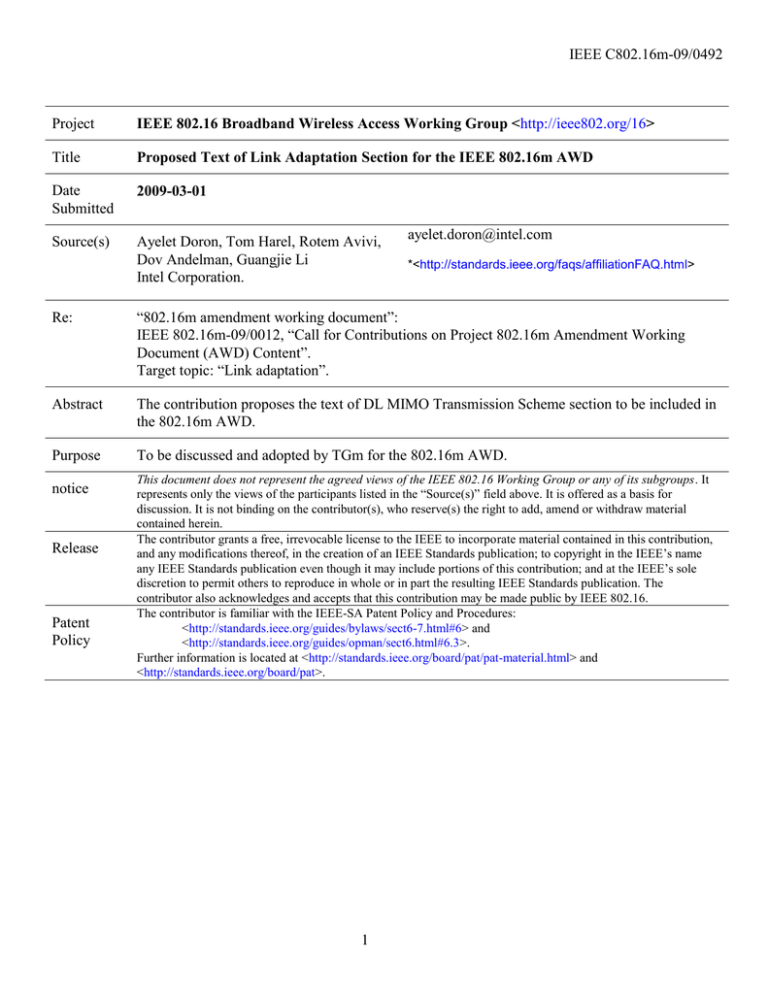IEEE C802.16m-09/0492 Project Title
advertisement

IEEE C802.16m-09/0492 Project IEEE 802.16 Broadband Wireless Access Working Group <http://ieee802.org/16> Title Proposed Text of Link Adaptation Section for the IEEE 802.16m AWD Date Submitted 2009-03-01 Source(s) Ayelet Doron, Tom Harel, Rotem Avivi, Dov Andelman, Guangjie Li Intel Corporation. ayelet.doron@intel.com *<http://standards.ieee.org/faqs/affiliationFAQ.html> Re: “802.16m amendment working document”: IEEE 802.16m-09/0012, “Call for Contributions on Project 802.16m Amendment Working Document (AWD) Content”. Target topic: “Link adaptation”. Abstract The contribution proposes the text of DL MIMO Transmission Scheme section to be included in the 802.16m AWD. Purpose To be discussed and adopted by TGm for the 802.16m AWD. notice Release Patent Policy This document does not represent the agreed views of the IEEE 802.16 Working Group or any of its subgroups. It represents only the views of the participants listed in the “Source(s)” field above. It is offered as a basis for discussion. It is not binding on the contributor(s), who reserve(s) the right to add, amend or withdraw material contained herein. The contributor grants a free, irrevocable license to the IEEE to incorporate material contained in this contribution, and any modifications thereof, in the creation of an IEEE Standards publication; to copyright in the IEEE’s name any IEEE Standards publication even though it may include portions of this contribution; and at the IEEE’s sole discretion to permit others to reproduce in whole or in part the resulting IEEE Standards publication. The contributor also acknowledges and accepts that this contribution may be made public by IEEE 802.16. The contributor is familiar with the IEEE-SA Patent Policy and Procedures: <http://standards.ieee.org/guides/bylaws/sect6-7.html#6> and <http://standards.ieee.org/guides/opman/sect6.html#6.3>. Further information is located at <http://standards.ieee.org/board/pat/pat-material.html> and <http://standards.ieee.org/board/pat>. 1 IEEE C802.16m-09/0492 Proposed Text of Link Adaptation Section for the IEEE 802.16m AWD Ayelet Doron, Tom Harel, Rotem Avivi, Dov Andelman,Guangjie Li Intel Corporation 1. Overview This contribution proposes text for the Link adaptation of the P802.16m AWD, based on the proposals outlined in the TGm SDD. The proposed text is developed so that it can be readily combined with IEEE P802.16 Rev2/D9 [1], it is compliant with the 802.16m SRD [2] and the 802.16m SDD [3], and it follows the style and format guidelines in [4]. 2. References [1] IEEE P802.16 Rev2/D9, “Draft IEEE Standard for Local and Metropolitan Area Networks: Air Interface for Broadband Wireless Access,” Jan 2009. [2] IEEE 802.16m-07/002r8, “802.16m System Requirements” [3] IEEE 802.16m-08/003r7, “The Draft IEEE 802.16m System Description Document” [4] IEEE 802.16m-08/043, “Style guide for writing the IEEE 802.16m amendment” 2 IEEE C802.16m-09/0492 3. Proposed Text ---------------------------------------------------------------------------[Please adopt the following text as indicated in the respective sections] 15 Advanced Air Interface 15.3 Physical layer 15.3.X Link Adaptation This section introduces the Link Adaptation scheme which adaptively adjusts radio link transmission formats in response to change of radio channel for both downlink and uplink. 15.3.X.1 DL Link Adaptation 15.3.X.1.1 Adaptive modulation and channel coding scheme Adaptive modulation and channel coding scheme for DL transmission shall be supported. The serving ABS shall adapt the modulation and coding scheme (MCS) level based on the DL channel quality indicator (CQI) reported by the AMS. DL control channel transmit power should be adapted based on DL channel quality indicator (CQI) reported by the AMS. The reported CQI feedback shall correspond to MCS levels of table XXX. The exact measurement method used to derive the CQI feedback is implementation specific. The CQI feedback shall apply to the feedback MIMO mode indicated by the corresponding Feedback Allocation IE. The CQI feedback together with the rank feedback (when applicable) composes the spectral efficiency value reported by the AMS. This value corresponds to the expected block error rate which is the closest, but not exceeding, a specific target error rate. The following reference parameters shall be assumed: Reference burst with a single FEC block, with the following specified allocation size. The reference FEC block size is determined according to the reported spectral efficiency. Table YYY Reference block size for CQI report Index MCS level Rank Number of LRUs per reference burst Reference FEC block size 1 [TBD] [TBD] [TBD] [TBD] 2 3 4 5 6 7 8 9 10 3 IEEE C802.16m-09/0492 11 12 13 14 15 16 17 18 19 20 21 22 23 24 25 26 27 28 29 30 31 32 In H-ARQ mode, the target error rate is measured on the first H-ARQ transmission The target error rate is defined as [TBD] % Adjustment of the report to frequency reuse factor and cell loading is FFS In order to allocate the AMS with MCS level and rank appropriate for the actual requirements, the ABS should make adjustments to the AMS reported spectral efficiency, by considering parameters values different from the reference ones and by adaptating to delay and mobility conditions. 15.3.X.2 UL Link Adaptation 15.3.X.1.1 Adaptive modulation and channel coding scheme Adaptive modulation and channel coding scheme for UL transmission shall be supported. The serving ABS shall adapt the modulation and coding scheme (MCS) level based on the UL channel quality estimation and the maximum transmission power of the AMS. UL control channel (excluding initial ranging channel) transmit power should be adapted based on UL power control. 4
